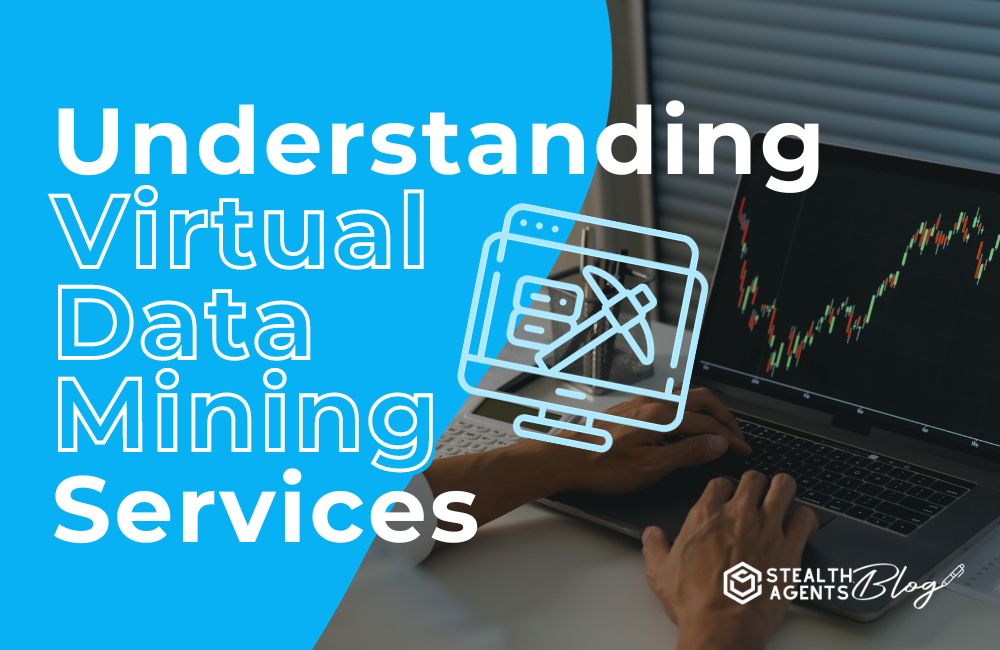Virtual data mining services help businesses uncover hidden patterns and make smarter decisions without needing in-house analysts or complex infrastructure. Stealth Agents provides expert virtual data mining support—so you can streamline operations, reduce costs, and focus on growth with confidence.
Data has become an essential element for businesses to survive and thrive. It holds valuable insights that can drive strategic decisions and provide a competitive edge.
However, with the exponential growth in data, organizations need efficient ways to extract meaningful information from vast data sets.
Virtual data mining services can be quite helpful in this situation. Therefore, don’t hesitate to call for help because there are tasks you can outsource to a data entry virtual assistant according to your needs.
And the best place to find one is at Stealth Agents, where they can offer a highly skilled Virtual Data Entry Analyst.
Discover our various pricing options and reserve your spot for a free consultation by booking online now.
What is a virtual data mining service?
Data mining involves analyzing massive datasets to discover patterns and insights. It starts with collecting and preprocessing data and selecting appropriate techniques like classification or clustering. After applying these techniques, analysts interpret the results to extract meaningful insights. Validation ensures the quality of findings. Finally, insights are deployed to inform decisions and strategies.
Virtual data mining refers to the use of virtual platforms and tools to conduct data mining activities remotely without the need for physical infrastructure.
Many businesses are always searching for methods to gain an advantage over their competitors by mining data. Extracting valuable insights from big data is crucial in modern business. Data mining plays an essential role in achieving this objective. By analyzing historical data, businesses can identify patterns, correlations, and trends that can significantly impact decision-making. Data mining gives firms a competitive advantage from customer segmentation to market analysis.
The difference between data mining from data analytics and warehousing
Data mining, analytics, and warehousing are integral components of the data management and analysis landscape, each serving distinct purposes.
Data mining delves into uncovering patterns and insights within vast datasets, employing statistical analysis, machine learning, and AI techniques.
On the other hand, data analytics involves a broader spectrum of methodologies, including descriptive, diagnostic, predictive, and prescriptive analytics, aimed at extracting actionable insights to drive decision-making.
Meanwhile, data warehousing focuses on the centralized collection, storage, and management of data from various sources, ensuring data consistency and quality for analytical purposes.
Together, these disciplines form the backbone of data-driven decision-making within organizations, leveraging data to effectively inform strategic and operational initiatives.
Virtual data mining tools
Here are five commonly used virtual data mining software and tools:
- RapidMiner: An open-source platform offering a wide range of data mining and analysis tools, including machine learning algorithms and predictive analytics.
- Weka: An open-source tool that compiles machine learning algorithms for tasks like data preprocessing, classification, regression, clustering, and association rule mining.
- KNIME: An open-source data analytics platform allowing users to visually create data flows, execute data analysis tasks, and integrate various data sources for data mining and machine learning.
- SAS Enterprise Miner: A commercial data mining software solution offering advanced analytics tools for data exploration, modeling, and deployment.
- Python with libraries like sci-kit-learn, pandas, and TensorFlow: Python is a versatile programming language employed for various purposes, such as extracting data and implementing machine learning algorithms. Due to its versatility, it is a widely popular language for these purposes. Libraries like sci-kit-learn, pandas, and TensorFlow provide extensive data mining and analysis support.
How businesses can benefit from virtual data mining service
Virtual data mining services can help businesses make better decisions and analyze data more effectively, especially for budget vs. actual expenses.

Improved decision-making
In the intricate dance of business decisions, clarity is paramount. Virtual data mining services provide a lens into nuanced patterns and correlations within data, empowering decision-makers with a more profound understanding. With insights from simulated environments, businesses navigate the decision-making landscape with increased confidence and precision.
Cost-effective solutions
Cost considerations are ever-present in the business equation. Virtual data mining services offer a cost-effective alternative by alleviating the need for exhaustive real-world data collection. The ability to simulate scenarios reduces resource requirements, making data mining more accessible and efficient for businesses with constrained budgets.
Privacy compliance
Privacy, a cornerstone of ethical data mining practices, is delicately woven into the fabric of virtual data mining services. Through advanced anonymization techniques, businesses can delve into data analysis without compromising individual privacy. This ensures compliance with regulations and fosters a trustful relationship with stakeholders.
Rapid prototyping and testing
In the dynamic landscape of business innovation, agility is a prized asset. A data analyst virtual assistant is a gem to virtual data mining services that facilitate rapid prototyping and testing, allowing businesses to experiment swiftly with various scenarios and data algorithms. Therefore, the agile approach improves data analysis by promoting continuous improvement and adaptation.
Enhanced algorithm performance

The versatility of virtual data mining services extends to their support for various algorithms. Businesses can select and refine algorithms based on the unique demands of their data mining tasks. One of the most important factors in extracting useful insights from complicated datasets is the improved algorithm performance that results from this flexibility.
Increasing production uptime
Virtual data mining is crucial in increasing production uptime by identifying patterns and trends within operational data that can help optimize processes and prevent downtime. It can also uncover correlations between factors such as equipment performance, environmental conditions, maintenance schedules, and production output by analyzing historical production data.
This analysis enables predictive maintenance strategies, allowing maintenance to be performed proactively before equipment failures occur, thus minimizing unplanned downtime. Virtual data mining can identify inefficiencies in production workflows and equipment usage, enabling optimization efforts to improve productivity and reduce disruptions. The insights can enhance production systems, leading to higher productivity and uptime for organizations.
Flexibility in experimentation
The controlled environments provided by virtual data mining services usher in a new era of experimentation. Businesses can customize scenarios to mirror their specific challenges, testing hypotheses and refining strategies in a safe and controlled space. Being able to try new things in a variety of ways fosters new ideas and data-driven findings.
How does virtual data mining service help every business
Here are some of the example how a virtual data mining service can help businesses analyze their problems in such data techniques of every dedicated virtual assistant.
Fraud detection in banking
Detecting unusual patterns in transaction data to identify potential fraudulent activities. Unusual spending patterns or transactions from unusual locations can trigger alerts for further investigation.
Customer sentiment analysis
Analyzing customer reviews on social media or review platforms to understand the sentiment towards a product or service. This helps businesses gauge customer satisfaction and make improvements if needed.
Stock market forecasting

Analyzing historical stock prices and market trends to predict future stock prices. Thus, investors and traders can use this information to make an informed decision about buying or selling stocks.
Loan approval in banking
A decision tree is used to determine whether a customer qualifies for a loan based on factors like credit score, income, and debt. Random Forests can enhance accuracy by combining the decisions of multiple decision trees.
Retail product recommendations
Identifying patterns in customer purchases to recommend related products. For instance, suggesting accessories or complementary items based on a customer’s previous buying history.
Improve marketing and sales efforts
Virtual data mining improves marketing and sales by analyzing online interactions, transactions, and demographics to understand customer behavior and preferences. It aids in personalizing marketing, identifying promising leads, optimizing pricing, and staying competitive through competitor analysis.
Customer churn prediction
Predicting whether a customer will likely leave a service (like a subscription or a telecom plan) based on their usage patterns and interactions. Moreover, businesses can then take proactive steps to retain those at risk of leaving.
Healthcare optimization
Explore a case where a healthcare provider leveraged virtual data mining to optimize patient care processes. By simulating different scenarios, the organization identified inefficiencies, leading to streamlined workflows and improved patient outcomes.
Retail forecasting
Delve into a retail case study where virtual data mining was employed to forecast consumer trends. Through simulated environments, the retailer gained insights into potential market shifts, allowing for proactive inventory management and targeted marketing strategies. In addition, if having difficulties in retailing, a virtual data mining service can come up with useful retail pricing strategies.
Personalizing education
A school district applied virtual data mining to understand student learning patterns actively. Also, teachers utilized simulated scenarios to gain insights into individual student needs, enabling the creation of personalized educational plans that fostered a more effective and nurturing learning environment.
Optimizing e-commerce
An online retailer actively harnessed virtual data mining to enhance its recommendation engine. Moreover, simulated environments were instrumental in identifying patterns in customer preferences, resulting in more accurate product recommendations, higher customer satisfaction, and increased sales.
Forecasting energy consumption
A utility company actively utilized virtual data mining to forecast energy consumption patterns in the energy sector. Simulations actively allowed for scenario testing, enabling the optimization of energy distribution and reduction of wastage. For this result, it can improve efficiency and a more sustainable approach.
Enhancing customer service
A telecommunications company actively harnessed virtual data mining to analyze customer service interactions. Simulated scenarios actively identified potential pain points and areas for improvement, leading to the implementation of targeted training programs and, subsequently, enhanced customer satisfaction.
Strengthening supply chain
A manufacturing firm actively employed virtual data mining to bolster its supply chain resilience. In addition, simulating various supply and demand scenarios actively allowed the company to identify vulnerabilities and implement contingency plans. This proactive approach actively mitigated risks and ensured uninterrupted operations.
Data mining techniques
Data mining techniques encompass various methods for extracting insights from large datasets.
These include classification, which categorizes data into predefined classes, clustering, which groups similar data points, and regression analysis for predicting numerical values based on variable relationships.
Association rule learning identifies patterns in transactional data, while anomaly detection spots outliers.
Sequence mining finds sequential patterns, text mining extracts insights from unstructured text, and spatial data mining analyzes geographic data.
Time series analysis is used for data collected over time.
These techniques are essential for uncovering valuable patterns and trends in data for various applications.
Factors to consider hiring a virtual data mining services
When choosing a virtual data mining service, consider data security, scalability, integration, and support. Ensure that the service provider follows robust data encryption methods, implements strict access controls, and offers seamless integration with your existing systems. Look for responsive customer support through phone, email, and live chat options. Understand your specific business needs to select a service provider that aligns with your objectives.
Evaluating the cost-benefit ratio
Before using a virtual data mining service, check if it’s worth the cost. Look for providers with clear pricing and flexible options to get the best value for your money. Virtual data mining can help you find hidden patterns in your data so you can make smart decisions that help your business grow. This can lead to more money, happier customers, and a better position in the market.
But you have to balance the cost with the benefits. Think about how much it will cost you to start and keep using the service. Also, consider any extra fees for advanced features or help. Make a smart choice that works with your budget and goals by comparing the cost to the benefits.
Takeaways
Data mining is vital because it uncovers hidden patterns and trends in large datasets, enabling predictive analytics, informed decision-making, and targeted marketing. It helps manage risks, personalize experiences, and optimize operations, driving innovation and efficiency across industries.
Data mining is not merely a technological toolkit; it’s a guiding light for decision-makers seeking to navigate the complexities of their operations. From predicting customer behavior to identifying potential fraud, each technique we explored serves as a beacon, illuminating paths toward enhanced efficiency, improved strategies, and a deeper understanding of the intricacies within vast datasets.













